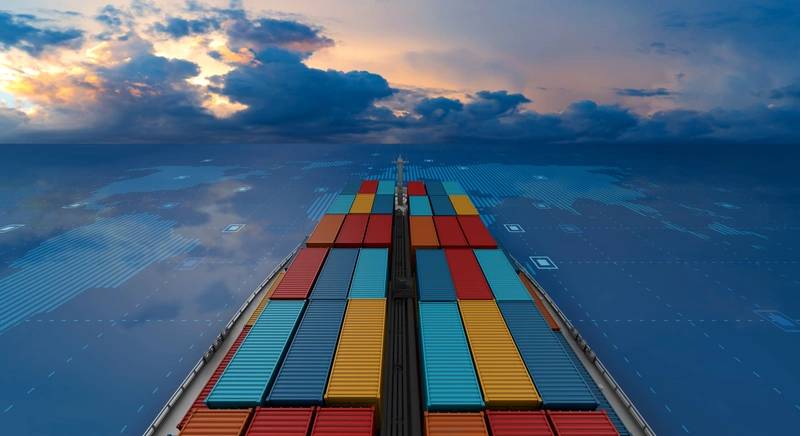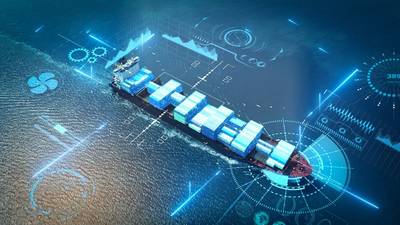Maritime Innovation: Fostering Creativity and Working to Make Bright Ideas Work
This is the dawning of the age of AI and Big Data, huge agglomerations of new and transformative energy; almost self-generating, always strengthening and pulling at the reins, seeking to break free and run, a prospect both exciting and terrifying. That image can imply a human is holding the reins. How quaint: these days, AI itself may be holding the reins.
In a review of innovation in 2023 – across any industrial or economic sector, not just maritime – AI looms large, a game-changer equivalent to IBM’s programming advances in the 1940s. Consider, for example, the pervasive reference and role for AI in a December 2022 report by ABS, the American Bureau of Shipping. The report – “Technology Trends, Exploring the Future of Maritime Innovation” – takes a predictive look at how 13 new technologies are likely to impact maritime systems and operations.
AI is presented as a stand-alone – and standout – topic, but critical for other sectors, from autonomous functions to generative design to digital twins to new visualization technologies (including the use of a “haptic suit,” which provides physical touch feedback, useful in training or operating remote vessels). Or perhaps more mundane: using AI across an ecosystem of autonomous vessels, smart ports, smart yards, smart buoys and smart beacons to optimize supply chains and reduce the risk of incidents at sea.
ABS expects maritime innovation, from now until 2050, to advance within three broad categories:
- Clean Energy Transition – hydrogen and nuclear power will dominate alternative energy developments with widespread adoption by 2050;
- Applied Research – look for “green ecosystems,” including vessel design and construction and green infrastructure, i.e., port operations and green corridors and cargo management; also, new materials, such as high magnesium steel and new manufacturing methods and applications; and,
- Digitalization – expect visualization technologies, e.g., high-fidelity virtual simulators with AI generated scenarios by 2030 and virtual immersive ship models by 2050 and connected unmanned autonomous vessels by 2040.
Gareth Burton, ABS Vice President, Technology, worked closely on the ABS report. He was asked about the status of some of the highlighted, innovative trends: are any ready for application now, or close to being ready? Some technologies, he said, remain conceptual, others are well advanced. He cited the use of AI, for example, within image identification systems for autonomous navigation.
“We anticipate AI to increase significantly,” Burton commented, “including the application of AI-based health monitoring and in self-awareness and self-maintaining systems.”
Burton said innovation is being driven from a number of sources, including -
- Small start-ups are transitioning available tech, e.g., from the automotive industry, to marine applications;•Ship owners are applying additive manufacturing capabilities as well as the use of visualization technologies;
- Shipyards are building digital twins;
- Governments have a role in establishing the framework that enables innovation; and,
- Academia – ABS works with a number of universities on maritime R&D.
Burton commented that “overall, success is a team sport. There is no one company or sector which can drive innovation across the industry.”
Burton was asked about new tech on existing vessels. Application can vary, he said, noting that much of the focus right now is on new vessels. However, he added that ongoing research, say with additive manufacturing, will have broader applications, particularly with replacement parts. Similarly, autonomous functions are being applied on existing vessels now. “There is a need,” he commented, “for some of the technologies to be adaptable to new and existing vessels.” That flexibility is of particular concern for vessels seeking to switch to new fuels.
 “We anticipate AI to increase significantly, including the application of AI-based health monitoring and in self-awareness and self-maintaining systems.” - Gareth Burton, ABS Vice President, Technology (Photo: ABS)
“We anticipate AI to increase significantly, including the application of AI-based health monitoring and in self-awareness and self-maintaining systems.” - Gareth Burton, ABS Vice President, Technology (Photo: ABS)
A Center for Maritime Innovation…?
In August, questions about how to advance and strengthen maritime innovation received a new and high-level focus. That’s when MARAD published a request for information (RFI) about establishing a “Center for Maritime Innovation” and how such a Center might be organized and structured. MARAD’s primary interest was in innovation regarding emerging environmental and transportation challenges.
MARAD received comments from 15 individuals and groups, mostly supportive of a new center. These comments addressed a number of specific topics raised by MARAD. Interestingly, however, many of the comments also encouraged MARAD to expand the Center’s scope, to address innovation beyond environment and transportation.
Consider, for example, suggestions from the Advanced Steel Processing and Products Research Center, located at the Colorado School of Mines in Golden, Colo. Their interest: R&D on “the next generation of steel.” A new MARAD Center, it was suggested, would benefit from “working collaboratively with a broad coalition of partners, including academic research institutions and existing public-private organizations with relevant maritime expertise.”
Also worth noting are numerous references of support for housing a new Center within the American Bureau of Shipping. The American Association of Port Authorities (AAPA), for example, writes that “ABS is well equipped to assemble a group of organizations representative of the breadth of the American maritime industry and its stakeholders.”
AAPA also suggests wider focus, that a new Center should take on a “broad base of challenges and opportunities within the maritime industry, including decarbonization, energy resilience, digitization, workforce development, and more.”
Two sets of comments are particularly expansive, covering a wide scope of issues with related, and extensive, advisory comments. Both filings deserve a close look. One because it was submitted by Crowley Maritime, one of the biggest maritime companies in the world. The second is from a group called the Maritime Accelerator for Resilience (MAR), a U.S.-based maritime innovation organization “working on the cutting edge of maritime and other innovation topics, with some of the most influential leaders in the fields of shipping, ocean policy and innovation.” Crowley proposes a framework built within and around Crowley’s Center for Transportation and Logistics, an academic center it supports at the University of North Florida in Jacksonville. MAR’s ideas suggest more of a shake-up: maritime innovation should be headquartered at the center of U.S. innovation – in Silicon Valley.
Here’s a closer look at some highlights.
Crowley Maritime
For Crowley, the purpose of a new Center should be “to act as a catalyst and platform for maritime industry growth while sustaining and restoring the natural maritime environment by interconnecting the various maritime and ocean innovation stakeholders in the United States.” The Jacksonville location would allow a Center to take advantage of existing maritime assets, from academic strengths to the region’s coastal and waterways geography to proximity to maritime suppliers and manufacturers.
Crowley envisions the Center forming an advisory partnership with MARAD, focusing on alternative fuels and propulsion, environmental protection and developing vessel and shoreside infrastructure. Another topic: workforce development and designing and providing training and education programs that further contribute to technological innovation.
In a section called “Service Offerings” Crowley proposes an “academic and industrial collaborative network.” This would include industry volunteers to mentor companies that join the new Center. Advisory boards would counsel new ideas to help them progress.
An accelerator program would concentrate on companies seeking to develop a defined product or prototype. Selected companies would receive help in developing a business model, seeking funding and be able to access tailored mentorship and related guidance.
Crowley cites the need to focus on “real world implementation of the solutions found.”
Crowley’s cost estimates are:
- Facilities and equipment, including a 22,000 ft2 hydrology/hydrodynamics laboratory housing a wave basin, wave channel/flume and an overhead gantry crane for scour and erosion modelling - $57 million;
- Annual operating costs, including salaries - $5.2 million; and,
- Program and Initiatives, covering “innovation challenges and hackathons” and networking, workshops and conventions - $1.3 million.
- Crowley breaks out income into four sources but doesn’t suggest how much each sector might provide.
- Industry partners
- Collaborative efforts with other research institutions
- Government grants
- Philanthropic and non-profit organizations.
This suggested planning outline, Crowley writes, could provide a “world-leading applied research institution designed to generate continuous innovation in the maritime space.”
 © nespix / Adobe Stock
© nespix / Adobe Stock
MAR – Maritime Accelerator for Resilience “Sea/Think/Do”
The principal author for MAR’s comments is Coast Guard Rear Admiral (retired) Jim Watson, whose service career, after graduating from the U.S. Coast Guard Academy, included stints as Chief of Staff of the CG 7th District, director of Prevention Policy at USCG HQ, Deepwater Horizon federal on-scene coordinator and President of ABS’s Americas Division, retiring in 2022.
The following individuals also contributed:
- Nishan Degnarain, CEO of ExO Mesh, an innovation advisory and investment firm based in Silicon Valley;
- Rich Mason, Executive Advisor for Parsons Corporation;
- Capt. Anuj Chopra, Co-founder and CEO ESGPlus LLC;
- Carleen Lyden Walker, Co-Founder and Executive Director of NAMEPA (North American Marine Environment Protection Association); and,
- Jonathan Kempe Founder, Source Consulting, based in New Zealand.
Go big or go home
MAR’s comments start with the observation that the U.S. maritime industry needs to transform itself, within a decade, in order to spearhead a competitive blue economy with a vibrant U.S. maritime sector at its center. To get there, however, requires “significantly more than small technical changes to ship designs; instead, a wholesale disruption to current mindsets and constraints.” MARs cites a benchmarking survey from McKinsey and Company that the U.S. maritime industry invests less than 1% of revenue into innovation or I.T. projects.
In contrast, competitor nations and allies invest heavily in maritime innovation. China is opening a $1 billion Ocean Innovation Center at Xiamen University and collaborating with the Asian Infrastructure investment Bank and the New Development Bank to scale up innovation. The U.K. is opening the Advanced Research and Invention Agency to ensure breakthroughs for critical U.K. industries. Scandinavian nations have maritime accelerators far more advanced than the U.S. The MARs team writes: “It is at this level of ambition that the U.S. Center for Maritime Innovation needs to operate, including across the U.S. Government too.”
MARs notes that the U.S. is home to the advanced technologies required to lead the global shipping industry. This raises the question: why haven’t these technologies been adapted for maritime use and a competitive U.S. industry? Potential payoffs are huge. MARs estimates an innovative renaissance could have an impact over $5 trillion by 2030.
MARs cites five major risk areas on which innovation needs to focus:
- Climate security – accelerating the transition to zero-emission fuels;
- Economic security – ensuring competitive transport of U.S. goods and addressing structural dependence on Tier 1 ports, which MARs calls “one of the biggest unaddressed causes of the 2021 supply chain crisis.” Smaller ports need to step up in activity and efficiency.
- National security – ensuring the U.S. has appropriate Sealift capacity;
- Energy and food security – adapting to “new climate and market realities;” and,
- Workforce security – a reference to workforce expansion and the ability to take ono new technologies, e.g., generative AI, robotics and autonomous systems.
 © Tierney / Adobe Stock
© Tierney / Adobe Stock
The model: Silicon Valley
MARs writes that innovative processes are more critical for success than organizational structure, and this should be a top concern as MARAD looks to select an organization to host a new Center. MARs lists four lessons from Silicon Valley critical for innovation:
- Build a Community of Maritime Innovators. A new Center must be relevant among universities, private research groups, mariners, and policymakers. “Having a way to engage and curate such a community is a critical skillset requirement,” MARS advises.
- Run an Accelerator Program - at big scale. Traditional accelerators, MARs writes, help about 20 companies a year. In contrast, MARs references efforts by the accelerator Y-Combinator which seeks to scale up its work by a factor of 100. “(This is) the sort of thinking needed to catalyze change in the U.S. maritime industry,” MARs states.
- Host an Annual Summit with leading innovators to confirm the biggest challenges are being addressed at scale.
- Run an investment fund. MARs suggests $100 million, minimum. Absent money, an innovation center is hollow, without credibility. “What is critical here,” MARs writes, “is that investment is appropriately incentivized based on performance of the fund.” Performance doesn’t just mean financial return. Rather, MARs suggests a broader evaluation: whether the fund is supporting projects that are demonstrably expanding U.S. maritime efficiency and capacity compared to competitor nations. If so, it’s a successful fund.
MARs makes the additional suggestion that for-profit organizations should be considered as a host entity. MARs pointedly writes “In the RFI, there is an unusual preference for the secretariat to be hosted by a non-profit organization.” It comments: “There has been no non-profit or industry incumbent that has disrupted an industry at the scale and pace that would be required for the U.S. maritime industry.”
Next steps…?
MARAD’s public comment period on the Center for Maritime Innovation closed in October. Next steps are unclear. A MARAD spokesperson said the agency couldn’t comment on where the innovation idea stands now.












